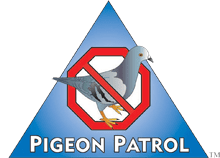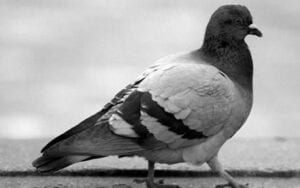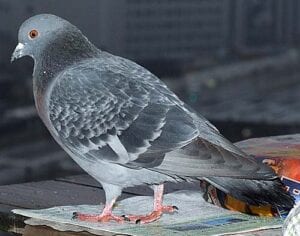
by Pigeon Patrol | May 25, 2021 | Bird Law, Bird Spikes, Doves, Pigeon Spikes, Pigeons
Most of the pigeons you see around a city, building, bridge, billboard or other structure, are pigeons that were born and raised close by. A few may be “vagrants” and constantly on the move, but most of them are going to be your neighborhood pigeons that will be nesting and breeding near to where you see them if food and water is close by.
Feral pigeons (Columbia livia) are the number one urban pest bird, causing damage where ever they nest or roost. Pigeons are descendants of domesticated European homing pigeons or Rock Doves, so they have a varied diet and feel at ease making their homes in man-made structures. Generally blue-grey in color, with iridescent feathers on the head and neck, pigeons often have markings in black, white or brown on the wings and neck. A short neck and small head characterize the standard pigeon; their short legs, hind toes and level front allow for both easy perching on pipes and ledges or walking on flat surfaces. Pigeons generally nest in small, flat areas away from the ground such as building ledges, air conditioning units or window sills.
Pigeons will inhabit any area that will offer them shelter from the climate, for example: architectural features of buildings, lofts, church steeples, attics, and any place with openings that allow for roosting, loafing, and nesting. Pigeon nests consist of twigs, sticks, and grass clumped together to form a platform. Pigeons are monogamous birds. “Eight to twelve days after mating, the female will lay 1 or 2 eggs which hatch after approximately 18 days. The male, during this time, is providing nesting material and guards the female and the nest.” When pigeons are born, they feed on pigeon milk which is “a liquid/solid substance secreted in the crop of both adults that is regurgitated” into the mouths of the young pigeons. Most young leave the nest at approximately 4 to 6 weeks of age. During this time another batch of eggs may have already been laid. Breeding most commonly occurs during the spring and fall, but reproduction can occur all year long. A flock of pigeons will normally have an equal amount of males and females. A pigeon’s normal lifespan in nature is about 3 to 4 years.
A pigeon can go, if necessary, a long time without food or even water. Most birds need a constant water source and that they will visit every day. Pigeons are skilled in finding water and food sources, and rarely have trouble finding a source in the city. Individual pigeons can have a home range of 150 miles, although most will stay close to home, which is generally considerably less than 25 miles or so. If their food and water sources change drastically, however, they will migrate, to another spot, near or far, with better provisions.
Damage caused by Pigeon Problems
Pigeon control is important due to the damage and disease problems these birds often create, check out Health Risk page. The uric acid in pigeon feces is highly corrosive and can cause extensive damage to metals and other substrates it sits on for long periods. Debris from flocks of problem pigeons often build up, backing up gutters and drains which can cause flooding and roof damage. Nesting materials and other debris has caused failures in machinery, especially rooftop air conditioning units which are a prime nesting spot for pigeons. Other frequent pigeon problems include slip and fall liability from feces or debris, plus an unclean, dirty company image is presented when pigeons are roosting all over a building or store front sign. The bacteria, fungal agents and ectoparasites found in pigeon droppings are responsible for a host of serious diseases, including histoplasmosis, encephalitis, salmonella, meningitis, toxoplasmosis and more. Pigeons also carry ectoparasites for example: fleas, lice, mites, ticks, and other biting pests. Many companies have significant clean up costs due to the pigeon problems that they don’t resolve. The pigeons that are located around airports threaten human safety due to a possible bird-aircraft collision. The U.S. Air Force considers pigeons as a medium priority hazard to jet aircrafts.
FLYING RATS ?
In today’s world, the common structure-dwelling pigeons have become the avian equivalents of city rodents. “Flying Rats,” as they have been described. Unfortunately, they have been forced into this role by man, as much as by their own natural instincts and habits. First and foremost to the problem of overpopulation, are the numbers of nooks and crannies that modern man builds into the exterior of all of his structures, forming the basic nesting home sites for pigeons and other birds. This means that almost every house, commercial building, bridge, billboard, gas canopy, or other large structure harbors a number of these potential nest or roosting sites. Bad for us, good for the pigeon.
Although pigeons are not very smart, they are creatures of habit and will try to return to the same places as before looking for a way back into it’s old nest site of favorite roosting spot, that’s call bird pressure.

Pigeons also become habituated to humans, by being extensively fed by humans, as in outdoor eating restaurants, parks and schools which only aggravates the problem. Pigeons, domesticated for thousands of years, are easily tamed and handled by humans. It is important to note that NO wild animals, including wild pigeons, should be fed, at any time, for any reason, by anyone.
Pigeon Control Products
The best pigeon control product is 2″ or 3/4” bird netting. Bird net is extremely durable and creates a true bird barrier against problem pigeons “homing” to their natural instinct to stay near their birth site. Pigeon netting completely controls pigeon problems, forcing the birds to look elsewhere for a nesting site.
In addition to bird net, other very effective bird control and pigeon control products are electrical shock track , bird spike, chemical bird control aversion hazing systems, OvoControl -birth control for pigeons, bird control post and wire systems and many other products. These pigeon control or bird control products work best where pigeons are nesting or roosting and the pigeons are “homing” (committed to remaining at the site). For pigeon problem areas where the birds are not nesting live catch pigeon traps can be an effective pigeon control method.
TOXICANTS AND POISONS
In certain areas, the use of a toxicant for pigeons is allowed for the control of pigeons. There are several types, the two most often used is a product with the brand name of “Avitrol”.
Both are used exactly the same way, by pre-baiting with ordinary feed corn or seed for 5 – 7 days and then when the pigeons or birds are accepting the bait readily, the corn is laced with the toxicant and doled out to the pigeons when the birds eat the treated bait the birds have a reaction, some act loopy and many die or get very sick. Then the process can be started again with pre-baiting for 5 – 7 days etc.. This process is very labor intensive if it is done correctly and according to label directions a service person must stay around and pick up dead and dying birds then remove any remaining treated bait so protected birds don’t get into the bait.
Unfortunately most of the time we see a Pest Control Technician putting a pie tin or something on a roof top, put in the bait and leaving the bait there all month long which will only make the birds that survive shy away from the corn. In most cases baiting when done right the affected pigeons die. No matter what kind of story some technician will give you, these bait products do not make the pigeons forget where they live, act like BIRDIE LSD, or make the pigeons act crazy and fly away, it kills many of them.
We do not use poison baits for any type of bird.
We feel Live Trapping is a much more effective solution.
These products all act as a poison to birds since they are flock reduction products and you carry the added liability of having a poisoned bird dropping into someone’s yard where the dog or cat can eat the baited bird and possibly get sick or worse yet die – Then who do you think your neighbors will be looking for to sue $$$
SOME UNUSUAL PIGEON FACTS
Remember to respect the pigeon. This chubby little bird has the uncanny ability to find it’s way home, no matter what, and no matter from where. To date, science can only theorize as to exactly how the pigeons do this.
Trying to discover or prevent pigeons from returning home, researchers have tried to confuse them in every way possible. By transporting them to a remote location: In the dark, in randomly rotating cages, with strong or weak magnetic fields, with flashing lights, and even anesthetized, or any combinations of these, (and others too) nothing seemed to affect their navigation skills, even in unfamiliar territories.
Pigeons are suspected of using magnetic structures already known to be in their brains, but there was still no change in their ability, even when tiny, removable magnets were attached to their heads, supposedly to confuse these structures.
RACING PIGEONS
Most people can’t tell the difference between a racing pigeon and a regular feral pigeon. Hobbyists race homing pigeons all over the world and U.S. hobbyists all across North America. They do lose birds occasionally, and those years when there is a poor return rate of the birds are said to correlate with strong magnetic storms. Alternatively, the birds may have found a more appealing park or gutter en route. Some pigeons you may see on the street, therefore, could be the pigeons that didn’t make it back home. Rescued pigeons, or birds of any kind, should not be handled. Actual domestic pigeons that have escaped from individual owners, are usually banded and can be identified by the National Pigeon Association. This website contains information and even a link on how to report lost pigeons. The pigeon’s owner will certainly appreciate any information you can supply, as a lost pigeons is an investment of time and money for the pigeon owner.
Source
Pigeon Patrol Products & Services is the leading manufacturer and distributor of bird deterrent (control) products in Canada. Pigeon Patrol products have solved pest bird problems in industrial, commercial, and residential settings since 2000, by using safe and humane bird deterrents with only bird and animal friendly solutions. At Pigeon Patrol, we manufacture and offer a variety of bird deterrents, ranging from Ultra-flex Bird Spikes with UV protection, Bird Netting, 4-S Bird Gel and the best Ultrasonic and audible sound devices on the market today.
Voted Best Canadian wholesaler for Bird Deterrent products ten years in a row.
Contact us at 1- 877– 4– NO-BIRD, (604) 585-9279 or visit our website at www.pigeonpatrol.ca
Pigeon/Pigeon Patrol / Pigeons Roosting / Vancouver Pigeon Control /Bird Spikes / Bird Control / Bird Deterrent / Pigeon Deterrent? Surrey Pigeon Control / Pest /Seagull deterrent / Vancouver Pigeon Blog / Birds Inside Home / Pigeons in the cities / Ice Pigeons/ What to do about pigeons/ sparrows , Damage by Sparrows, How To Keep Raccoons Away, Why Are Raccoons Considered Pests/ De-fence / Pigeon Nesting/ Bird Droppings / Pigeon Dropping/ woodpecker control/ Professional Bird Control Company/ Keep The Birds Away/ Birds/rats/ seagull/pigeon/woodpecker/ dove/sparrow/pidgeon control/pidgeon problem/ pidgeon control/flying rats/ pigeon Problems/ bird netting/bird gel/bird spray/bird nails/ bird guard

by Pigeon Patrol | May 25, 2021 | Bird Deterrent Products, Bird Law, Bird Netting, Bird Spikes, Pigeon Control, Pigeon Droppings, Pigeon Patrol's Services
When it comes to birds, there may be more than just avian flu to be worried about. It has been suggested that there are over 60 other diseases that birds and their droppings can carry. The problem is especially worrisome in residential areas, as many of them are airborne and can be transferred to humans just by being around droppings.
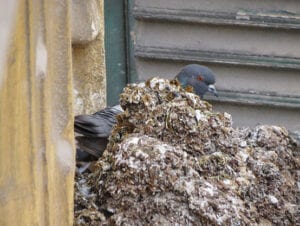
a pigeon bird standing by guano manure
Chicken farms can be fairly easily secured. With a combination of visual scare devices, sonic distress call emitters, ultrasonic disrupters and roost inhibitors other birds shouldn’t be a problem. If farmers just took this preventative action it could help contain the bird flu outbreak a good deal.
- Histoplasmosis is a respiratory disease that may be fatal. It results from a fungus growing in dried bird droppings.
- Candidiasis is a yeast or fungus infection spread by pigeons. The disease affects the skin, the mouth, the respiratory system, the intestines and the urogenital tract, especially the vagina. It is a growing problem for women, causing itching, pain and discharge.
- Cryptococcosis is caused by yeast found in the intestinal tract of pigeons and starlings. The illness often begins as a pulmonary disease and may later affect the central nervous system. Since attics, cupolas, ledges, schools, offices, warehouses, mills, barns, park buildings, signs, etc. are typical roosting and nesting sites, the fungus is apt to found in these areas.
- St. Louis Encephalitis, an inflammation of the nervous system, usually causes drowsiness, headache and fever. It may even result in paralysis, coma or death. St. Louis encephalitis occurs in all age groups, but is especially fatal to persons over age 60. The disease is spread by mosquitoes which have fed on infected house sparrow, pigeons and house finches carrying the Group B virus responsible for St. Louis encephalitis.
- Salmonellosis often occurs as “food poisoning” and can be traced to pigeons, starlings and sparrows. The disease bacteria are found in bird droppings; dust from droppings can be sucked through ventilators and air conditioners, contaminating food and cooking surfaces in restaurants, homes and food processing plants.
- E.coli. Cattle carry E. coli 0157:H7. When birds peck on cow manure, the E. coli go right through the birds and the bird droppings can land on or in a food or water supply.
Besides being direct carriers of disease, nuisance birds are frequently associated with over 50 kinds of ectoparasites, which can work their way throughout structures to infest and bite humans. About two-thirds of these pests may be detrimental to the general health and well-being of humans and domestic animals. The rest are considered nuisance or incidental pests.
A few examples of ectoparasites include:
- Bed bugs (Cimex lectularius) may consume up to five times their own weight in blood drawn from hosts which include humans and some domestic animals. In any extreme condition, victims may become weak and anemic. Pigeons, starlings and house sparrows are known to carry bed bugs.
- Chicken mites (Dermanyssus gallinae) are known carriers of encephalitis and may also cause fowl mite dermatitis and acariasis. While they subsist on blood drawn from a variety of birds, they may also attack humans. They have been found on pigeons, starlings and house sparrows.
- Yellow mealworms (Tenebrio molitor), perhaps the most common beetle parasites of people in the United States, live in pigeon nests. It is found in grain or grain products, often winding up in breakfast cereals, and may cause intestinal canthariasis and hymenolespiasis.
- West Nile Virus while West Nile is technically not transmitted to humans from birds, humans can get infected by the bite of a mosquito who has bitten an infected bird. The obvious lesson is that the fewer birds there are in any given area, the better. This translates into a smaller chance of an infected bird in that area, a smaller chance of a mosquito biting an infected bird and then biting a human.
Pigeon Patrol Products & Services is the leading manufacturer and distributor of bird deterrent (control) products in Canada. Pigeon Patrol products have solved pest bird problems in industrial, commercial, and residential settings since 2000, by using safe and humane bird deterrents with only bird and animal friendly solutions. At Pigeon Patrol, we manufacture and offer a variety of bird deterrents, ranging from Ultra-flex Bird Spikes with UV protection, Bird Netting, 4-S Bird Gel and the best Ultrasonic and audible sound devices on the market today.
Voted Best Canadian wholesaler for Bird Deterrent products ten years in a row.
Contact us at 1- 877– 4– NO-BIRD, (604) 585-9279 or visit our website at www.pigeonpatrol.ca
Pigeon/Pigeon Patrol / Pigeons Roosting / Vancouver Pigeon Control /Bird Spikes / Bird Control / Bird Deterrent / Pigeon Deterrent? Surrey Pigeon Control / Pest /Seagull deterrent / Vancouver Pigeon Blog / Birds Inside Home / Pigeons in the cities / Ice Pigeons/ What to do about pigeons/ sparrows , Damage by Sparrows, How To Keep Raccoons Away, Why Are Raccoons Considered Pests/ De-fence / Pigeon Nesting/ Bird Droppings / Pigeon Dropping/ woodpecker control/ Professional Bird Control Company/ Keep The Birds Away/ Birds/rats/ seagull/pigeon/woodpecker/ dove/sparrow/pidgeon control/pidgeon problem/ pidgeon control/flying rats/ pigeon Problems/ bird netting/bird gel/bird spray/bird nails/ bird guard
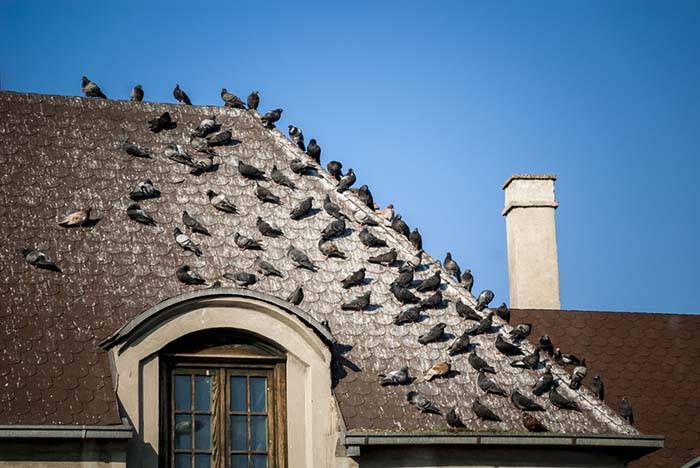
by Pigeon Patrol | May 17, 2021 | Bird Netting, Bird Spikes, Pigeon Control, Pigeon Droppings
Pigeons are easily recognizable by their distinct coloring. With their white-gray rump, iridescent facial feathers and black stripes on their tails and wings, these birds are easy to identify. Pigeons reproduce incredibly quickly, and mating occurs year round. Despite their speedy reproduction rates, pigeons are monogamous creatures that lay one or two eggs at a time, which hatch within 18 days. Baby pigeons are fed “pigeon milk,” or regurgitated food, by both their parents until they are old enough to find food on their own.
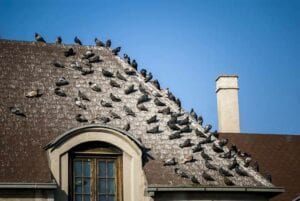
Pigeon Habits
Pigeons prefer grains, but they are not picky when it comes to their meals. Much of their diet comes from humans who drop or spill their food, or place leftovers in open trash cans that pigeons can scavenge. These birds like to hang out on ledges and other narrow areas high above the ground. They like to roost in covered, high areas, and their nests can frequently be found in places like steeples or under bridges.
Pigeon Habitats
Pigeons are true city dwellers who are dependent on humans to provide food, roosting and nesting sites. This is why you often see them gathered around city parks, buildings and bridges. Pigeons are also commonly found around agricultural areas, as well as warehouses, feed mills and grain elevators.
Pigeon Threats
Often called the “rats of the sky,” pigeons can be incredibly problematic. These birds can carry dangerous diseases like cryptococcosis, toxoplasmosis, salmonella, food poisoning and more. Their droppings may also harbor the growth of fungus, which causes histoplasmosis, which can accelerate the aging of structures and statues. Even more alarming, these social birds often serve as unwitting hosts to fleas, lice, mites, ticks and other pests, which can create secondary infestations.
Signs You Have a Pigeon Infestation
The most obvious sign of a pigeon infestation is the presence of many birds, pigeon nests or their droppings.
How To Prevent an Infestation
The best way to prevent pigeons from roosting in or near your house is to make your home undesirable. Remove any and all food they could get access to, place pointy objects on pigeon-friendly surfaces and place nets across open areas.
How to Get Rid of Pigeons
The steps for pigeon removal and prevention are the same: make their living space uninhabitable. Killing pigeons is not effective and it will not root out the source of the problem. Instead, eliminate all food sources and remove their nests and replace them with objects that prevent them from returning.
Source
Pigeon Patrol Products & Services is the leading manufacturer and distributor of bird deterrent (control) products in Canada. Pigeon Patrol products have solved pest bird problems in industrial, commercial, and residential settings since 2000, by using safe and humane bird deterrents with only bird and animal friendly solutions. At Pigeon Patrol, we manufacture and offer a variety of bird deterrents, ranging from Ultra-flex Bird Spikes with UV protection, Bird Netting, 4-S Bird Gel and the best Ultrasonic and audible sound devices on the market today.
Voted Best Canadian wholesaler for Bird Deterrent products ten years in a row.
Contact us at 1- 877– 4– NO-BIRD, (604) 585-9279 or visit our website at www.pigeonpatrol.ca
Pigeon/Pigeon Patrol / Pigeons Roosting / Vancouver Pigeon Control /Bird Spikes / Bird Control / Bird Deterrent / Pigeon Deterrent? Surrey Pigeon Control / Pest /Seagull deterrent / Vancouver Pigeon Blog / Birds Inside Home / Pigeons in the cities / Ice Pigeons/ What to do about pigeons/ sparrows , Damage by Sparrows, How To Keep Raccoons Away, Why Are Raccoons Considered Pests/ De-fence / Pigeon Nesting/ Bird Droppings / Pigeon Dropping/ woodpecker control/ Professional Bird Control Company/ Keep The Birds Away/ Birds/rats/ seagull/pigeon/woodpecker/ dove/sparrow/pidgeon control/pidgeon problem/ pidgeon control/flying rats/ pigeon Problems/ bird netting/bird gel/bird spray/bird nails/ bird guard
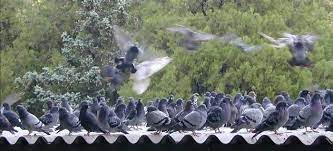
by Pigeon Patrol | May 10, 2021 | Bird Deterrent Products, Bird Law, Bird Netting, Bird Spikes, Columbidae, Pigeon Predators, Pigeon Spikes
Most of us love having backyard birds to watch and to feed. The music of songbirds is a sure sign of spring. On the other hand, bird damage to lawns can be extensive. If you’re finding small holes in your grass and you see a lot of birds around, the damage is probably caused by birds foraging for food. There are some ways you can keep birds from digging up lawn and grass. Read on to learn more.
Why are Birds Digging up my Lawn?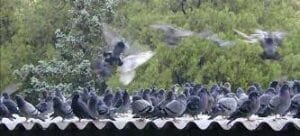
It’s not hard to identify bird damage to lawns. If you see a lot of birds in your yard and you find small, about one-inch (2.5-cm.) holes in the turf, it’s most likely bird-related damage. What are birds digging for in your lawn? The phenomenon of birds digging holes in lawns has an easy explanation: food. They’re looking for tasty snacks, so if you’re seeing a lot of bird damage, it means you have an insect problem. Basically, your lawn is the best restaurant around because it has so many bugs. Birds are simply foraging for grubs, worms, and insects. The good news about this is that the grubs and insects will actually do more damage to your lawn than the birds will, and the birds are helping you control the population.
How to Keep Birds from Digging up Lawn
If you want to avoid the bird damage of small holes all over your lawn, you have to get rid of the insect pests. To get rid of your bug problem, invest in a pesticide, preferably something natural. You can either have it applied by a professional lawn company or you can do it yourself. It is important to time the application. If you have grubs, for instance, you need to apply in late spring or early summer. It’s also important to time application to avoid harming the birds. Apply the pesticide in late afternoon so it will be dry by the next morning when the birds reappear to search for breakfast. If you prefer not to have birds at all around your property, there is little you can do but you can try using a few scare tactics that may keep the birds away.
Source
Pigeon Patrol Products & Services is the leading manufacturer and distributor of bird deterrent (control) products in Canada. Pigeon Patrol products have solved pest bird problems in industrial, commercial, and residential settings since 2000, by using safe and humane bird deterrents with only bird and animal friendly solutions. At Pigeon Patrol, we manufacture and offer a variety of bird deterrents, ranging from Ultra-flex Bird Spikes with UV protection, Bird Netting, 4-S Bird Gel and the best Ultrasonic and audible sound devices on the market today.
Voted Best Canadian wholesaler for Bird Deterrent products ten years in a row.
Contact us at 1- 877– 4– NO-BIRD, (604) 585-9279 or visit our website at www.pigeonpatrol.ca
Pigeon/Pigeon Patrol / Pigeons Roosting / Vancouver Pigeon Control /Bird Spikes / Bird Control / Bird Deterrent / Pigeon Deterrent? Surrey Pigeon Control / Pest /Seagull deterrent / Vancouver Pigeon Blog / Birds Inside Home / Pigeons in the cities / Ice Pigeons/ What to do about pigeons/ sparrows , Damage by Sparrows, How To Keep Raccoons Away, Why Are Raccoons Considered Pests/ De-fence / Pigeon Nesting/ Bird Droppings / Pigeon Dropping/ woodpecker control/ Professional Bird Control Company/ Keep The Birds Away/ Birds/rats/ seagull/pigeon/woodpecker/ dove/sparrow/pidgeon control/pidgeon problem/ pidgeon control/flying rats/ pigeon Problems/ bird netting/bird gel/bird spray/bird nails/ bird guard

by Pigeon Patrol | May 10, 2021 | Bird Law, Bird Spikes, Pigeon Control, Pigeon Droppings, Pigeon Patrol's Services
Color of Pigeons
Usually bluish-gray with black bands and reddish feet.
What does a pigeon look like?
Pigeons have broad and pointed wings, with small heads and short legs. They also have a wide and rounded tail. Their coat is blueish grey. They have a soft voice with guttural series of rolling coos.
Where are pigeons found?
Originally found wild in Europe, North Africa, and western Asia, feral pigeons have become established in cities around the world. The lack of adequate sanitation, deliberate feeding of the birds by humans, and “cliff-type” nesting sites on older buildings are the principal factors that attract pigeons to cities.
They will inhabit roofs, ledges, drain spouts, lofts, attics, caves, etc. They also frequent parks and sidewalks, where they become habituated to people feeding them. Pigeons are mainly creatures of habit and tend to feed, nest, and roost in the same place day after day.
Pigeons are a pest in most urban areas in the US. On the West Coast our local pest control specialists find pigeons affect many of our customers in cities such as Boise, Roseburg, Salinas, Spokane, Novato, and Palm Springs.
What do pigeons eat?
These bird-brained beauties also eat livestock manure; they’re not picky, and actually pretty disgusting. (But please don’t feed the birds. They do carry diseases.) Other favorite treats include seeds, grains, some fruits and green feed; but will feed on insects.
Pigeon life span
Pigeons pair for life, which may last for 15 years or longer. In urban environments, they may live for 3-4 years. Pigeons have a hearing range close to humans, but they have a poor sense of taste and smell. Remember—they eat manure. They also exhibit distinct behavioral patterns like nesting, feeding, roosting, and loafing. Nesting and roosting sites (places where they sleep or rest) may occur in the same area or be as far as 5 miles apart.
Breeding occurs year-round with 1-2 eggs per batch. The eggs hatch after 17-19 days of incubation, and young pigeons will leave the nest after 4 to 6 weeks. More eggs may be laid before the first young are gone. An adult pigeon eats about one pound of food a week. Pigeons, their nests, and droppings are of major concern because 50 or more diseases and ectoparasites are associated with them.
Diseases spread by pigeons
Pigeons are of great medical concern because more than 50 diseases and ectoparasites are associated with them, which leads to their description by non-romantics as flying rodents. Pigeon nests and droppings will also lead to dermestid beetles, flies, clothes moths, and stored product pest infestations within buildings.
-
Asthma – bird dropping can dry up and become dust. Once inhaled, this can trigger asthma attacks.
-
Salmonella – also known as food poisoning, but droppings can lead to the contamination of food.
-
Listeriosis, histoplasmosis, cryptococcosis – all fungal diseases that can come from growing on pigeon droppings.
-
Diseases from parasites – pigeons often carry ticks and fleas which can lead to things like Lyme disease and other illnesses associated with those pests.
Signs of a pigeon problem
How do you know if you have just a few pigeons or if you have a serious problem? Well, there are signs that the pigeons around your property may be causing problems. They include:
-
Large numbers of birds – just take a look around your property and see how many pigeons there are. Once one decides to set up shop, others are likely to follow. Are there a lot of birds on the ground? Are there more roosting above? Are people having trouble just walking through the area because of the number of birds?
-
Nesting material – pigeons use sticks, twigs, branches, leaves and even garbage to make up their nests. Is there an increased number of this material lying around? Pigeons are not famous for their neatness, so if there is an increase of debris, it could be from too many pigeons trying to nest.
-
Droppings – pigeons are rather notorious for the deposits that they leave behind. Are there so many that it makes it hard to walk? If so, time to call in the pros.
How to keep pigeons away
Got pigeon issues? Due to the problems that can come with these birds, you should have an infestation addressed right away. There are ways to keep pigeons away, such as spikes. Read more about these techniques below. Plus, you should make sure pigeons cannot get to standing water or food on your property. Get rid of garbage or food that has been spilled, so pigeons may find a spot less appealing.
Pigeon control methods
There are many techniques for excluding pigeons from an infested structure. Exclusion strategies include structural modification, bird netting, plastic and metal spikes, monofilament and steel lines, and trapping. In addition, gels, paste, and liquids can also be used for excluding the birds from the structure.
Structural modification: Birds like to land on flat surfaces. When the building ledges are angled (45 degrees), it prevents birds from landing on building edges. Sheet metals, styrofoam blocks, wood, stone, and other materials can be used to give the desired angle.
Bird netting: There are several types of bird nettings that can be used for exclusion. In general, netting provides the best long-term control in keeping the birds out of a structure. In warehouses and commercial buildings where bird activity is a major concern, bird nets can be used to prevent the birds from getting into overhead pipes, roof air conditioning units can be netted off from the birds, etc.
Plastic and metal spikes: Spikes can be used as a physical barrier in preventing the birds from landing on an area, such as perching on ledges and beams of buildings. Spikes have sharp pointed edges extending out at angles. They can be installed around ledges, roof peaks, eaves, window sills, or any places that are prone to roosting. Because netting and spikes are more effective long-term control methods, they are the preferred methods.
Pigeon repellent
Pigeon repellents are available in different formulations such as gel, paste and liquids. They differ considerably in cost, effectiveness, and texture (thick and tacky, jelly like or viscous).
Choose the one that works best based on the experience. These repellents are not non-toxic and because of their “sticky” properties cause the birds to move elsewhere.
How to get rid of pigeons
If you’re dealing with pigeons, you should contact a pest professional to figure out how to eliminate these pests. As you may have noticed, pigeons can get droppings on buildings, damaging the appearance of these structures. Their droppings can also pollute zones of human activity as well as food. A Western Exterminator expert can ascertain how to handle the situation and help you know how to inhibit these birds for the future.
Bird control solutions from Western Exterminator
Pigeons aren’t the only birds home and business owners need to be concerned about. Seagulls and starlings are known to cause damage and spread disease as well. With proper identification, our specialists can create bird control plans specifically made for you to ensure your property is bird-free.
Pigeon Patrol Products & Services is the leading manufacturer and distributor of bird deterrent (control) products in Canada. Pigeon Patrol products have solved pest bird problems in industrial, commercial, and residential settings since 2000, by using safe and humane bird deterrents with only bird and animal friendly solutions. At Pigeon Patrol, we manufacture and offer a variety of bird deterrents, ranging from Ultra-flex Bird Spikes with UV protection, Bird Netting, 4-S Bird Gel and the best Ultrasonic and audible sound devices on the market today.
Voted Best Canadian wholesaler for Bird Deterrent products ten years in a row.
Contact us at 1- 877– 4– NO-BIRD, (604) 585-9279 or visit our website at www.pigeonpatrol.ca
Pigeon/Pigeon Patrol / Pigeons Roosting / Vancouver Pigeon Control /Bird Spikes / Bird Control / Bird Deterrent / Pigeon Deterrent? Surrey Pigeon Control / Pest /Seagull deterrent / Vancouver Pigeon Blog / Birds Inside Home / Pigeons in the cities / Ice Pigeons/ What to do about pigeons/ sparrows , Damage by Sparrows, How To Keep Raccoons Away, Why Are Raccoons Considered Pests/ De-fence / Pigeon Nesting/ Bird Droppings / Pigeon Dropping/ woodpecker control/ Professional Bird Control Company/ Keep The Birds Away/ Birds/rats/ seagull/pigeon/woodpecker/ dove/sparrow/pidgeon control/pidgeon problem/ pidgeon control/flying rats/ pigeon Problems/ bird netting/bird gel/bird spray/bird nails/ bird guard
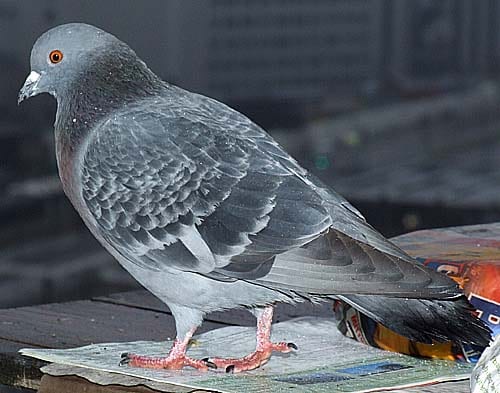
by Pigeon Patrol | May 3, 2021 | Animal Deterrent Products, Bird Deterrent Products, Bird Netting, Bird Spikes, history of pigeons, Pigeon Control, Pigeon Patrol's Services, Pigeon Spikes
Need pigeon removal in your hometown?
Pigeons are a determined bird, doggedly living near humans because of the ample food supply. These birds are indiscriminate eliminators of waste, leaving liquid splatters of dropping anywhere they travel. Their lack of concern for cleanliness extends into their everyday activities, and water contamination has been traced back to pigeon carcasses and feces in water towers near roosting sites. The waste from these birds, which are most commonly seen in urban areas, is very corrosive. Concrete, limestone and metal all suffer from the ill-effects of pigeon droppings. In cities, constant cleanup alone costs thousands of dollars.
Because of the homing ability of pigeons, there are difficulties with relocation. This species of bird was once used as a messenger between civilizations, finding their way over hundreds and thousands of miles. The only way to get rid of pigeons is to discourage them and prevent them from frequenting undesired locations. There are a number of ways to accomplish this, some proven to show more success than others. Information about pigeon trapping – analysis and methods for how to trap.
Unsuccessful methods of pigeon control deal mostly with predator fear. Plastic owls are a favorite of the public when, in reality, the fake predator appears as just that—fake. A pigeon will not be any more leery of an unmoving owl than it would an unmoving human. Pigeons are largely unaffected by unpleasant smells, though it has recently been proven that their homing ability is based on scent mapping and not electromagnetic fields. Sounds are another flop when it comes to pigeon control. Ultrasonic sound emitters may very well produce noises humans can’t hear, but rarely are those sounds ‘annoying’ to birds. If a pigeon can put up with all the noise congestion in a busy city, some random sounds from an ultrasonic radio aren’t going to bother it.
The most practical ways to get rid of pigeons is to convince them that they do not or cannot stay near your home or business. Any ledge can be a roosting site. By installing pigeon nets, bird spikes or electric shockers, pigeons will be less inclined to settle on those surfaces. Nets and spikes prevent roosting all together. Electric strips may be difficult to install at higher locations, but many brands offer solar power and require little maintenance. Electric strips do require more attention than netting and are often more expensive. If your building has smaller sections of roof, bird “spiders” are useful instruments. The wire device resembles a sprinkler in design with thin lines of arced metal extending outward from a central location. These wires are loose and are not strong enough to support the weight of a bird.
Information about how to keep pigeons away – prevention techniques.
There is something to be said for determination, too. Even though most scare tactics do not work on pigeons, harassment techniques can prove beneficial if done frequently and without fail. If pigeons have taken over your yard, letting your dog out will chase them away. Yes, they will come back when the dog is gone, but if this scenario is repeated often enough the pigeons will learn that your yard is not the easiest place to visit. When it comes to opportunistic birds, life is all about easy.
Some towns and cities have experimented with employing the use of falcons to control pigeon populations. The benefit to using birds of prey is that they often keep the pigeons moving, preventing any one roosting area to become long-term. Unfortunately, falcons cannot eliminate a large enough number of the nuisance birds to make a noticeable difference without becoming a nuisance bird themselves.
Pigeons are products of their environment. If they were not deliberately fed in parks and on streets a decline in their nuisance behaviors would be seen. These birds can live on naturally occurring food sources. Unfortunately, it is the poor sanitation habits of people that keep these animals desiring our leftovers. If pigeons have overrun your home, be sure that all garbage and compost is carefully disposed of. You may not be able to control the habits of the neighbors on your block, but you can make your house that much more uninviting by following good hygiene habits.
Pigeon Information & Facts
Pigeon Appearance: Pigeons are robust birds with short necks, usually gray in color with a faint iridescence to their feathers. They have a characteristic back and forth rhythm to their head. This bobbing is a mechanism that allows the birds to focus their vision and perceive depth. Pigeons have duplicate black bands on each wing, but the coloration on the main part of the body can vary. Their feet are suited for perching on ledges and high peaks. The beak of the pigeon is medium in both length and width, ideal for pulling apart bread, picking up small food pieces, or fishing spiders out of cracks.
Pigeon Habitat and Behavior: Pigeons are most often seen in cities. This habitat preference is largely due to the surplus of food available and the high roosting opportunities. Pigeons are fond of the water towers on tall buildings, often building messy nests on the rim. For this reason, most cities require water towers be completely sealed to prevent the birds or their waste from contaminating the water supply. A pigeon will nest almost anywhere and will often do so with many others of its kind. A roost can be made atop any vertical surface. Pigeons are known in invade gutters, ducts, air conditioners, attics, warehouses, and drains. They are not overly concerned with sanitary conditions and will utilize any vertical object in any location for their purposes.
Pigeons are also very food-driven. This problem has been made serious by the continued, deliberate feeding of the birds in urban areas. The birds have little fear of humans and will often converge around people in parks and near restaurants. Pigeon feeding is a common hobby of many city-goers, yet another reason for the lack of caution around humans.
Egg laying can take place as often as every other month. Courtship between the male and the female is brief, and the resulting egg clutch usually only contains two eggs. An abundance of pigeons will result in quick overpopulation, regardless of how many eggs are laid per pair. Some cites have sought population control by replacing viable eggs with fake or unfertilized eggs. This tactic may be effective short-term, but pigeons will lay another clutch once the original appears unproductive.
Pigeon Diet: Pigeons will scavenge for almost any type of grain-based food source. The habit of city restaurants discarding stale bread into parks increases the role this type of food plays in the pigeon diet. In nature, the birds eat insects, berries, seeds, grains, and spiders.
Pigeon Nuisance Concerns: Pigeons are not as bold as some species of birds adapted to living off human leftovers. The major concern when it comes to this species centers on its roosting habits. Pigeons most often roost in number. They are not a sanitary bird, often eliminating waste in their own nests, and living on top of the bodies of their own kind. Pigeon waste is caustic and will do permanent damage to stone and concrete. In many cities, water contamination due to pigeons and their droppings has been a major concern. Because these birds pool around areas with a high opportunity for food (such as restaurants), there is a logical concern for public health.
Pigeon Diseases: The most common zoonotic disease associated with pigeons is called histoplasmosis. This disease is caused by a fungal infection facilitated by the dried powder of pigeon feces. People with compromised immune systems should also be wary of cryptococcosis, another fungal infection affecting only those without healthy defenses. Psittacosis, more commonly transmitted by exotic birds, has been reported in larger cities. These illnesses present with flu-like symptoms, making diagnosis and treatment difficult unless the disease is well underway.
This site is intended to provide pigeon education and information, so that you can make an informed decision if you need to deal with a pigeon problem. This site provides many pigeon control articles and strategies, if you wish to attempt to solve the problem yourself. If you are unable to do so, which is likely with many cases of pigeon removal, please go to the home page and click the USA map, where I have wildlife removal experts listed in over 500 cites and towns, who can properly help you with your nuisance pigeon.
Pigeon Patrol Products & Services is the leading manufacturer and distributor of bird deterrent (control) products in Canada. Pigeon Patrol products have solved pest bird problems in industrial, commercial, and residential settings since 2000, by using safe and humane bird deterrents with only bird and animal friendly solutions. At Pigeon Patrol, we manufacture and offer a variety of bird deterrents, ranging from Ultra-flex Bird Spikes with UV protection, Bird Netting, 4-S Bird Gel and the best Ultrasonic and audible sound devices on the market today.
Voted Best Canadian wholesaler for Bird Deterrent products ten years in a row.
Contact us at 1- 877– 4– NO-BIRD, (604) 585-9279 or visit our website at www.pigeonpatrol.ca
Pigeon/Pigeon Patrol / Pigeons Roosting / Vancouver Pigeon Control /Bird Spikes / Bird Control / Bird Deterrent / Pigeon Deterrent? Surrey Pigeon Control / Pest /Seagull deterrent / Vancouver Pigeon Blog / Birds Inside Home / Pigeons in the cities / Ice Pigeons/ What to do about pigeons/ sparrows , Damage by Sparrows, How To Keep Raccoons Away, Why Are Raccoons Considered Pests/ De-fence / Pigeon Nesting/ Bird Droppings / Pigeon Dropping/ woodpecker control/ Professional Bird Control Company/ Keep The Birds Away/ Birds/rats/ seagull/pigeon/woodpecker/ dove/sparrow/pidgeon control/pidgeon problem/ pidgeon control/flying rats/ pigeon Problems/ bird netting/bird gel/bird spray/bird nails/ bird guard



